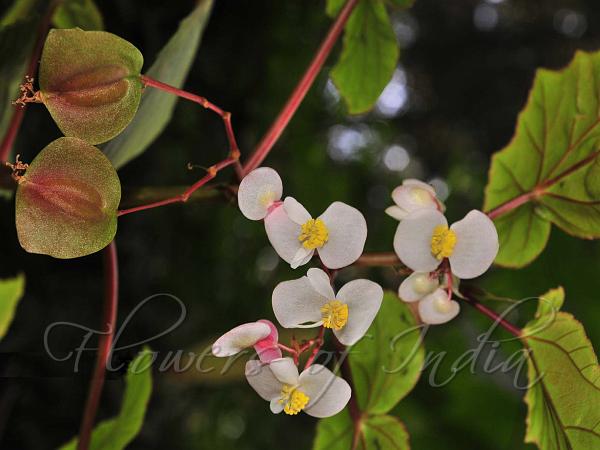|
| Malabar Begonia |
|

|

| File size | 298590 |
| Original date | 1/16/17 3:48 PM |
| Resolution | 1592 x 1194 |
| Flash | Flash fired, return detected |
| Focal length | 40.0mm |
| Exposure time | 1/60s |
| Aperture | 8.0 |
| Focus Distance | |
| Metering Mode | Multi-segment |
| Camera make | NIKON CORPORATION |
| Camera model | NIKON D300S |
| Sensor type | OneChipColorArea |
|
|
|
|
Photo: |
Botanical name: Begonia malabarica Family: Begoniaceae (Begonia family)
Synonyms: Begonia hydrophila, Begonia fallax, Begonia rubrosetulosa
Synonyms: Begonia hydrophila, Begonia fallax, Begonia rubrosetulosa
Malabar Begonia is a herb with stem often 2 ft
long, repeatedly dividing, with many leaves.
Flowers arise in leaf axils, with flower-cluster-stalks rarely exceeding
2-3 inches. Flowers are rose colored, not very many on a peduncle. Males
flowers have 4 tepals, and female flowers have 3 tepals. This features
clearly distinguishes it from
Two-Petal Begonia. Leaves are 2-4
inches, heart-shaped, pointed, very unequal at the base, with toothed margin.
Leaf-stalks are 1-5 inches long. Stipules are 5 mm, persistent, ovate
pointed, hairless.
Capsules are 1.8 x 1.8 cm, including the wings.
Medicinal uses:  Malabar Begonia is an important medicinal plant whose main secondary
metabolites are luteolin, quercetin and β-sitosterol. The leaves are
used for the treatment of respiratory infections, diarrhoea, blood
cancer and skin diseases. Very few reports on cultivation, breeding and
improvement programmes and in vitro studies of B. malabarica are
available despite its commercial importance.
Malabar Begonia is an important medicinal plant whose main secondary
metabolites are luteolin, quercetin and β-sitosterol. The leaves are
used for the treatment of respiratory infections, diarrhoea, blood
cancer and skin diseases. Very few reports on cultivation, breeding and
improvement programmes and in vitro studies of B. malabarica are
available despite its commercial importance.
 Malabar Begonia is an important medicinal plant whose main secondary
metabolites are luteolin, quercetin and β-sitosterol. The leaves are
used for the treatment of respiratory infections, diarrhoea, blood
cancer and skin diseases. Very few reports on cultivation, breeding and
improvement programmes and in vitro studies of B. malabarica are
available despite its commercial importance.
Malabar Begonia is an important medicinal plant whose main secondary
metabolites are luteolin, quercetin and β-sitosterol. The leaves are
used for the treatment of respiratory infections, diarrhoea, blood
cancer and skin diseases. Very few reports on cultivation, breeding and
improvement programmes and in vitro studies of B. malabarica are
available despite its commercial importance. | Identification credit: Navendu Pāgé | Photographed in Western Ghats. |
• Is this flower misidentified? If yes,